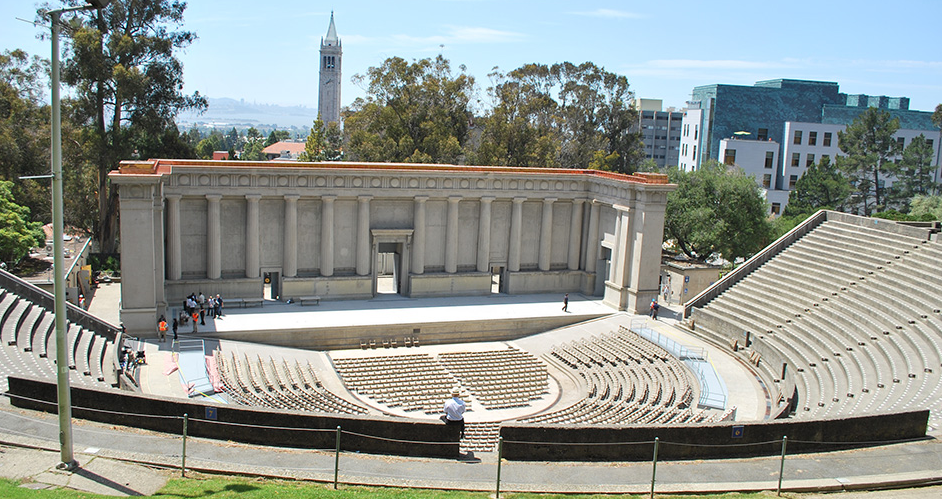In the pantheon of historic architecture, Berkeley’s Greek Theatre stands as a veritable Olympian. Its majestic columns and sweeping amphitheater echo the grandeur of ancient Greece, a testament to the enduring legacy of Hellenic culture. Unveiled in 1903, this magnificent edifice was designed by campus architect John Galen Howard with initial funding from William Randolph Hearst. Constructed on a natural hillside slope at the University of California, Berkeley, it is modeled after an ancient Greek theater at Epidaurus.
The design represents a timeless connection between antiquity and modernity, symbolizing not only architectural evolution but also continuity through its faithful adherence to traditional Greek architectural norms.
Beyond its striking facade and structural marvels lies an entity that has profoundly influenced Berkeley’s cultural and social landscape for over a century. The Greek Theatre has served as a vibrant hub for diverse events ranging from commencement ceremonies to music concerts, attracting global icons like Bob Dylan and Dalai Lama. Moreover, it has facilitated transformative dialogues on contemporary issues while upholding classical values of democratic discourse epitomized by ancient Greece.
This dual role – as an aesthetic monument reflecting historical heritage and an active forum stimulating intellectual growth – underscores its significance in fostering community cohesion and nurturing public spirit among Berkeley residents.
Unveiling the Origins of the Iconic Amphitheater
The Greek Theatre in Berkeley, known officially as the William Randolph Hearst Greek Theatre, was established in 1903 and serves as a testament to the deep appreciation for ancient architecture; for instance, its design replicates the ancient Greek amphitheater Epidaurus, thus embodying an iconic symbol of cultural exchange and historical reverence.
Commissioned by newspaper magnate William Randolph Hearst and designed by architect John Galen Howard, this remarkable structure evokes grandeur through its semicircular seating plan flanked by a colonnaded background – a design element that is distinctly reminiscent of traditional Hellenistic theaters.
This architectural marvel was constructed using locally sourced materials such as concrete and steel to withstand the test of time. With over 8,500 seats spread across terraces with stunning views of the San Francisco Bay area, it harks back to a time when theater played an essential role in community bonding and democratic discourse.
In addition to its architectural significance, the theatre has also played host to myriad notable events throughout history that further underscored its cultural impact. It served as an important venue during both World Wars where several rallies were held; these events demonstrably bolstered national unity at critical junctures in American history.
Moreover, it has seen performances from legendary artists like The Grateful Dead and Bob Dylan which have left indelible marks on popular culture. Thus, beyond being just a physical manifestation of ancient influence on modern Western architecture, The Greek Theatre represents shared human experiences encompassing artistry and socio-political movements alike – thereby fostering an enduring sense of belonging among those who have graced its premises or been part of its storied history.
Impact on Berkeley’s Cultural and Social Landscape
Diversity and vibrancy of cultural expressions in Berkeley have been significantly enriched by the iconic amphitheater, which has also fostered social cohesion among its residents.
As a nexus for performing arts, it has been instrumental in bringing together diverse communities, thereby reinforcing Berkeley’s reputation as a culturally inclusive city.
The Greek Theatre’s offerings, ranging from concerts to theatrical productions to university events and even political rallies, has provided ample opportunities for residents and visitors alike to engage with each other and with various aspects of local and global cultures.
In an attempt to evoke an emotional response about the amphitheater’s impact on Berkeley’s cultural landscape, consider the following:
1. The Greek Theatre as a Tool for Cultural Education: By hosting performances that span diverse genres and cultures, the theatre offers audiences exposure to different artistic practices from around the world. This helps enhance cultural literacy within the community.
2. A Venue for Local Talent: The theatre has always encouraged local artists by providing them with a platform to showcase their talent. This not only nurtures creativity but also instills a sense of pride within the community.
3. Community Building through Shared Experiences: The shared experience of attending events at this historic venue creates bonds between community members who otherwise might not interact with each other, fostering a strong sense of unity.
4. Preserving Heritage: Through its existence and continued operation, the Greek Theatre serves as a tangible link between modern-day Berkeley and ancient Greece – thus helping preserve historical connections while inspiring respect for past civilizations.
In conclusion, through its rich history and wide-ranging influence on culture and society in Berkeley, the Greek Theatre continues to be more than just an architectural landmark; it is indeed an embodiment of collective identity that resonates deeply within every resident’s subconscious desire for belonging.


